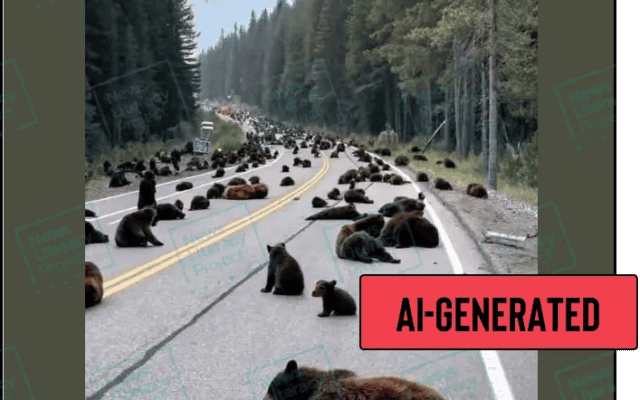As grizzly bears groggily emerge from hibernation in Yellowstone and Grand Teton national parks, a different kind of bear story went viral this March: one that had nothing to do with biology and everything to do with satire, AI, and social media misinformation.
It began with a Facebook post on March 23, 2025, World Bear Day. The page You Should See This shared a photo of what appeared to be hundreds of black and grizzly bears standing shoulder to shoulder on a road near Yellowstone, supposedly blocking the park’s entrance. The post claimed scientists were “deeply unsettled” by the animals’ behavior, suggesting the bears “know something we don’t.”
Some bears were said to be holding signs. Others allegedly nodded at each other in unison. It was complete fiction, intended as satire, But that didn’t stop the story from spreading like wildfire. Despite the absurdity and the original source being a satire site, the image racked up tens of thousands of shares, comments, and reactions. The story was soon stripped of its disclaimers and reposted elsewhere as if it were real.

Click image to see the original Facebook post.
The Real Science: Bears Are Back, Just Not Protesting
Meanwhile, in the actual Yellowstone and Grand Teton parks, real grizzly activity was indeed underway. The National Park Service reported the first paw prints on March 9, and a trail camera captured a bear lumbering across the snow just days later. These early sightings, mostly of adult male grizzlies, mark the start of bear season, an annual and very real event that comes with safety reminders for tourists and locals alike.
Bears waking from hibernation are particularly hungry and will often seek out animal carcasses exposed by melting snow. Human-bear conflict spikes during this period, especially when food is improperly stored or visitors venture too close. Last year, the region saw a record number of such incidents, prompting park officials to step up outreach this spring. None of these real updates, however, featured bears blockading roads with protest signs.
The Anatomy of a Viral Fake
According to Snopes and RumorGuard, the viral image originated on a page that openly declares its content as satire. The AI-generated photo was even used in a different fabricated story earlier this year about a bear blockade in Missouri. Still, the combination of realistic imagery, timely release during bear season, and satirical tone blurred the lines for many users. Platforms like Facebook and X amplified the content, often without context, leading users to question whether Yellowstone was under ursine occupation.
“This is a classic case of what we call ‘stolen satire,’” noted the News Literacy Project’s RumorGuard. “Satirical content is lifted from its original context and shared as if it were fact, often without disclaimers or source citations.”
Lead Stories, another fact-checking group, confirmed the image was AI-generated using detection tools. No credible wildlife agency reported any bear-related blockades. Yellowstone National Park, which remains partially snow-covered, had not even opened all its entrances at the time of the post.
Why People Fell for It
The bear story is humorous and harmless on the surface, but it underscores a growing issue: the inability of many social media users to distinguish satire, AI-generated visuals, and legitimate news. Animal content is especially potent in this regard, striking an emotional chord and demanding less skepticism than stories about politics or policy. As misinformation researchers point out, the viral bear image failed every credibility test: authenticity, source verification, evidence, context, and reasoning. Yet, it spread faster than most verified reports about actual bear sightings.
Emotionally charged content, especially content that surprises or amuses us, gets shared more often. It bypasses our natural skepticism because we want others to feel the same shock or delight. It becomes less about is this true? and more about you’ve gotta see this!
The image accompanying the hoax was AI-generated, but convincing enough to fool the average viewer. Thanks to rapid advancements in generative tools, photos can now be created or altered without any of the obvious giveaways people once relied on, ike blurry edges or odd proportions. Unless someone looks closely or reverse-searches the image, it’s easy to assume that a viral post with a realistic photo is legitimate. And because it was shared on World Bear Day, the timing gave it an added layer of believability. Unfortunately, when satire is copied and reposted without context or disclaimers, many people can’t tell it apart from genuine reporting, especially when the original tone is stripped away.
References:
- Kuta, S. (2025, March 28). Grizzly Bears Are Emerging From Their Dens in Yellowstone, Grand Teton National Parks. Smithsonian Magazine. https://www.smithsonianmag.com/smart-news/its-officially-grizzly-bear-season-in-yellowstone-grand-teton-national-parks-180986326/
- Liles, J. (2025, March 25). Yellowstone rumor claiming hundreds of bears blocked park entrance originated as satire. Snopes. https://www.snopes.com/fact-check/bears-blockade-yellowstone-entrance/
- RumorGuard. (2025, March 27). Image showing hundreds of bears blocking entrance to Yellowstone is fake. https://www.rumorguard.org/post/image-showing-hundreds-of-bears-blocking-entrance-to-yellowstone-is-fake



